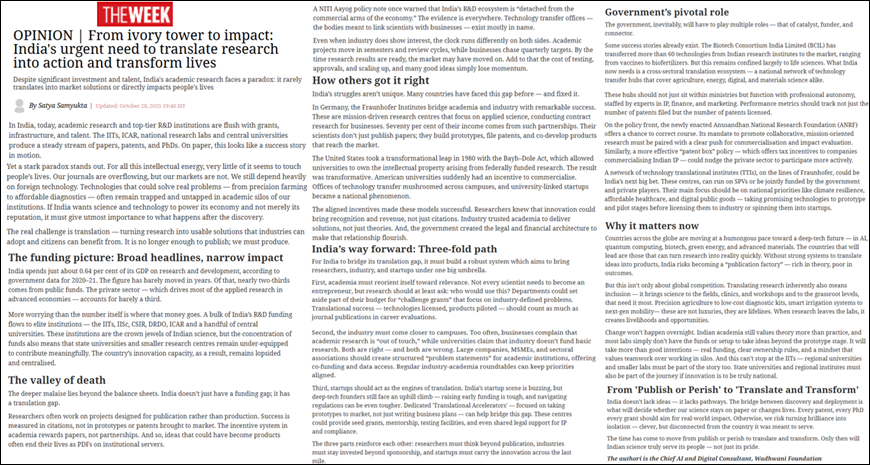Di India, saat ini, penelitian akademis dan lembaga-lembaga penelitian dan pengembangan tingkat atas dibanjiri dengan dana hibah, infrastruktur, dan talenta. IIT, ICAR, laboratorium penelitian nasional dan universitas-universitas pusat menghasilkan banyak sekali makalah, paten dan PhD. Di atas kertas, hal ini terlihat seperti sebuah kisah sukses yang sedang berjalan.
Namun, sebuah paradoks yang mencolok terlihat. Untuk semua energi intelektual ini, hanya sedikit sekali yang menyentuh kehidupan masyarakat. Jurnal-jurnal kita melimpah ruah, namun pasar kita tidak. Kita masih sangat bergantung pada teknologi asing. Teknologi-teknologi yang dapat memecahkan masalah-masalah nyata - dari pertanian presisi hingga diagnosa yang terjangkau - sering kali masih terperangkap dan tidak dimanfaatkan dalam silo-silo akademis dari institusi-institusi kami. Jika India ingin sains dan teknologi menjadi kekuatan ekonominya dan bukan hanya reputasinya, India harus memberikan perhatian penuh pada apa yang terjadi setelah penemuan tersebut.
Tantangan yang sebenarnya adalah penerjemahan - mengubah penelitian menjadi solusi yang dapat diadopsi oleh industri dan masyarakat. Tidak cukup hanya dengan mempublikasikan; kita harus memproduksi.
Gambaran pendanaan: Berita utama yang luas, dampak yang sempit
India menghabiskan hanya sekitar 0,64 persen dari PDB-nya untuk penelitian dan pengembangan, menurut data pemerintah untuk tahun 2020-21. Angka ini hampir tidak berubah dalam beberapa tahun terakhir. Dari jumlah tersebut, hampir dua pertiganya berasal dari dana publik. Sektor swasta - yang mendorong sebagian besar penelitian terapan di negara-negara maju - hanya menyumbang sepertiganya.
Yang lebih mengkhawatirkan daripada jumlah itu sendiri adalah ke mana uang itu mengalir. Sebagian besar dana penelitian dan pengembangan India mengalir ke lembaga-lembaga elit - IIT, IISc, CSIR, DRDO, ICAR dan beberapa universitas pusat. Institusi-institusi ini adalah permata mahkota dari ilmu pengetahuan India, tetapi konsentrasi dana ini juga berarti bahwa universitas-universitas negeri dan pusat-pusat penelitian yang lebih kecil masih kurang diperlengkapi untuk memberikan kontribusi yang berarti. Akibatnya, kapasitas inovasi negara ini tetap timpang dan terpusat.
Lembah kematian
Kesulitan yang lebih dalam terletak di luar neraca keuangan. India tidak hanya memiliki kesenjangan pendanaan; India juga memiliki kesenjangan penerjemahan.
Para peneliti sering kali mengerjakan proyek yang dirancang untuk publikasi, bukan untuk produksi. Keberhasilan diukur dari kutipan, bukan dari prototipe atau paten yang dibawa ke pasar. Sistem insentif di dunia akademis lebih menghargai karya tulis, bukan kemitraan. Jadi, ide-ide yang bisa menjadi produk sering kali berakhir sebagai PDF di server institusi.
Sebuah catatan kebijakan NITI Aayog pernah memperingatkan bahwa ekosistem penelitian dan pengembangan India “terlepas dari lengan komersial ekonomi.” Buktinya ada di mana-mana. Kantor-kantor transfer teknologi - badan-badan yang dimaksudkan untuk menghubungkan para ilmuwan dengan para pelaku bisnis - sebagian besar hanya ada dalam nama.
Bahkan ketika industri menunjukkan ketertarikannya, waktu berjalan secara berbeda di kedua belah pihak. Proyek akademis bergerak dalam siklus semester dan tinjauan, sementara bisnis mengejar target kuartalan. Pada saat hasil penelitian siap, pasar mungkin sudah pindah. Ditambah lagi dengan biaya pengujian, persetujuan, dan peningkatan skala, dan banyak ide bagus yang kehilangan momentum.
Bagaimana orang lain melakukannya dengan benar
Perjuangan India tidaklah unik. Banyak negara telah menghadapi kesenjangan ini sebelumnya - dan memperbaikinya.
Di Jerman, Fraunhofer Institutes menjembatani dunia akademis dan industri dengan kesuksesan yang luar biasa. Ini adalah pusat penelitian yang digerakkan oleh misi yang berfokus pada ilmu pengetahuan terapan, melakukan penelitian kontrak untuk bisnis. Tujuh puluh persen dari pendapatan mereka berasal dari kemitraan semacam itu. Para ilmuwan mereka tidak hanya menerbitkan makalah; mereka membuat prototipe, mengajukan paten, dan bersama-sama mengembangkan produk yang mencapai pasar.
Amerika Serikat melakukan lompatan transformasional pada tahun 1980 dengan Bayh-Dole Act, yang memungkinkan universitas untuk memiliki kekayaan intelektual yang muncul dari penelitian yang didanai oleh pemerintah. Hasilnya sangat transformatif. Universitas-universitas di Amerika tiba-tiba memiliki insentif untuk melakukan komersialisasi. Kantor-kantor transfer teknologi menjamur di seluruh kampus, dan perusahaan rintisan yang terkait dengan universitas menjadi fenomena nasional.
Insentif yang selaras membuat model-model ini berhasil. Para peneliti tahu bahwa inovasi dapat mendatangkan pengakuan dan pendapatan, bukan hanya kutipan. Industri mempercayai akademisi untuk memberikan solusi, bukan hanya teori. Dan, pemerintah menciptakan arsitektur hukum dan keuangan untuk membuat hubungan tersebut berkembang.
Jalan India ke depan: Jalur tiga kali lipat
Agar India dapat menjembatani kesenjangan penerjemahannya, India harus membangun sebuah sistem yang kuat yang bertujuan untuk menyatukan para peneliti, industri, dan perusahaan rintisan di bawah satu payung besar.
Pertama, akademisi harus mengubah orientasi mereka ke arah relevansi. Tidak semua ilmuwan harus menjadi pengusaha, tetapi penelitian setidaknya harus bertanya: siapa yang akan menggunakan hasil penelitian ini? Departemen-departemen dapat menyisihkan sebagian dari anggaran mereka untuk “hibah tantangan” yang berfokus pada masalah-masalah yang ditentukan oleh industri. Keberhasilan translasi - teknologi yang dilisensikan, produk yang diujicobakan - harus diperhitungkan sama pentingnya dengan publikasi jurnal dalam evaluasi karir.
Kedua, industri harus lebih dekat dengan kampus. Terlalu sering, bisnis mengeluh bahwa penelitian akademis “tidak relevan”, sementara universitas mengklaim bahwa industri tidak mendanai penelitian dasar. Keduanya benar - dan keduanya salah. Perusahaan besar, UMKM, dan asosiasi sektoral harus membuat “pernyataan masalah” yang terstruktur untuk institusi akademik, menawarkan pendanaan bersama dan akses data. Pertemuan rutin antara industri dan akademisi dapat menjaga keselarasan prioritas.
Ketiga, perusahaan rintisan harus bertindak sebagai mesin penerjemah. Dunia startup di India sedang berkembang pesat, tetapi para pendiri perusahaan teknologi masih menghadapi jalan terjal - mengumpulkan pendanaan awal sangatlah sulit, dan menavigasi peraturan bisa jadi lebih sulit lagi. ‘Akselerator Penerjemahan’ yang berdedikasi - yang berfokus untuk membawa prototipe ke pasar, bukan hanya menulis rencana bisnis - dapat membantu menjembatani kesenjangan ini. Pusat-pusat ini dapat memberikan hibah awal, bimbingan, fasilitas pengujian, dan bahkan dukungan hukum bersama untuk IP dan kepatuhan.
Ketiga bagian tersebut saling menguatkan satu sama lain: para peneliti harus berpikir lebih dari sekadar publikasi, industri harus tetap berinvestasi lebih dari sekadar sponsor, dan startup harus membawa inovasi ke tahap selanjutnya.
Peran penting pemerintah
Pemerintah, mau tidak mau, harus memainkan banyak peran - sebagai katalisator, penyandang dana, dan penghubung.
Beberapa kisah sukses sudah ada. Biotech Consortium India Limited (BCIL) telah mentransfer lebih dari 60 teknologi dari lembaga-lembaga penelitian India ke pasar, mulai dari vaksin hingga pupuk hayati. Tetapi hal ini masih terbatas pada ilmu-ilmu kehidupan. Apa yang India butuhkan saat ini adalah sebuah ekosistem alih teknologi lintas sektoral - sebuah jaringan nasional pusat alih teknologi yang mencakup pertanian, energi, digital, dan ilmu material.
Pusat-pusat ini seharusnya tidak hanya berada di dalam kementerian tetapi berfungsi dengan otonomi profesional, dikelola oleh para ahli di bidang IP, keuangan, dan pemasaran. Metrik kinerja harus melacak tidak hanya jumlah paten yang diajukan tetapi juga jumlah paten yang dilisensikan.
Di sisi kebijakan, Anusandhan National Research Foundation (ANRF) yang baru saja dibentuk menawarkan kesempatan untuk memperbaiki arah. Mandatnya untuk mempromosikan penelitian kolaboratif yang berorientasi pada misi harus dipasangkan dengan dorongan yang jelas untuk komersialisasi dan evaluasi dampak. Demikian pula, kebijakan “kotak paten” yang lebih efektif - yang menawarkan insentif pajak kepada perusahaan-perusahaan yang mengkomersialkan Kekayaan Intelektual India - dapat mendorong sektor swasta untuk berpartisipasi lebih aktif.
Sebuah jaringan institut translasi teknologi (TTI), seperti yang dilakukan oleh Fraunhofer, dapat menjadi taruhan besar berikutnya bagi India. Pusat-pusat ini, dapat berjalan dengan SPV atau didanai bersama oleh pemerintah dan pemain swasta. Fokus utama mereka haruslah pada prioritas nasional seperti ketahanan iklim, perawatan kesehatan yang terjangkau, dan barang publik digital - membawa teknologi yang menjanjikan ke tahap prototipe dan percontohan sebelum melisensikannya ke industri atau mengubahnya menjadi perusahaan rintisan.
Mengapa ini penting sekarang
Negara-negara di seluruh dunia bergerak dengan kecepatan yang sangat tinggi menuju masa depan teknologi canggih - dalam bidang AI, komputasi kuantum, bioteknologi, energi hijau, dan material canggih. Negara-negara yang akan memimpin adalah mereka yang dapat mengubah penelitian menjadi kenyataan dengan cepat. Tanpa sistem yang kuat untuk menerjemahkan ide-ide menjadi produk, India berisiko menjadi sebuah “pabrik publikasi” - kaya akan teori, tetapi miskin akan hasil.
Namun, ini bukan hanya tentang persaingan global. Menerjemahkan penelitian pada dasarnya juga berarti inklusi - membawa ilmu pengetahuan ke ladang, klinik, dan lokakarya serta ke tingkat akar rumput, yang paling membutuhkannya. Pertanian presisi hingga alat diagnostik berbiaya rendah, sistem irigasi pintar hingga mobilitas generasi mendatang - ini bukanlah kemewahan, ini adalah jalur kehidupan. Ketika penelitian keluar dari laboratorium, penelitian menciptakan mata pencaharian dan peluang.
Perubahan tidak akan terjadi dalam semalam. Akademisi India masih lebih menghargai teori daripada praktik, dan sebagian besar laboratorium tidak memiliki dana atau persiapan untuk membawa ide melampaui tahap prototipe. Dibutuhkan lebih dari sekadar niat baik - pendanaan yang nyata, aturan kepemilikan yang jelas, dan pola pikir yang menghargai kerja sama tim daripada bekerja secara terpisah-pisah. Dan hal ini tidak dapat berhenti di IIT - universitas regional dan laboratorium yang lebih kecil juga harus menjadi bagian dari cerita ini. Universitas negeri dan institut regional juga harus menjadi bagian dari perjalanan ini jika inovasi ingin benar-benar menjadi nasional.
Dari ‘Terbitkan atau Musnah’ menjadi ‘Terjemahkan dan Transformasikan’
India tidak kekurangan ide - India hanya kekurangan jalur. Jembatan antara penemuan dan penerapan adalah apa yang akan menentukan apakah ilmu pengetahuan kita tetap berada di atas kertas atau mengubah kehidupan. Setiap paten, setiap PhD, setiap hibah harus bertujuan untuk memberikan dampak di dunia nyata. Jika tidak, kita berisiko mengubah kecemerlangan menjadi keterasingan - pintar, tetapi terputus dari negara yang seharusnya dilayani.
Waktunya telah tiba untuk beralih dari menerbitkan atau musnah menjadi menerjemahkan dan mentransformasi. Hanya dengan begitu, ilmu pengetahuan India akan benar-benar melayani masyarakatnya - bukan hanya kebanggaannya.
Sumber Online:
PrintSource:




